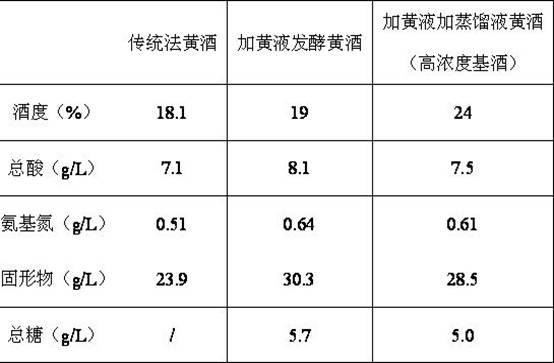Brewing method of high-concentration yellow rice wine
A rice wine brewing and high-concentration technology, applied in the preparation of alcoholic beverages, etc., can solve the problems of inconvenient quality control of rice wine, occupying labor resources, and occupying more base wine, etc., to improve site utilization, less bacteria pollution, and quality The effect of small fluctuations
- Summary
- Abstract
- Description
- Claims
- Application Information
AI Technical Summary
Problems solved by technology
Method used
Image
Examples
Embodiment 1
[0021] 1) Take 1 ton of rice and put it into a rice soaking tank, add water to completely submerge the rice and soak for 48 hours, then wash it and put it in a rice steamer, after steaming, cool it with water to the rice temperature of 26±1°C, mix evenly with half a catty of wine medicine, put Put it into the stainless steel fermentation tank for pre-fermentation. Add 1 ton of water 48 hours after the start of the pre-fermentation, add 0.09±0.01 tons (8%-10%) of wheat koji and 0.66 tons of steamed rice (1.2±0.05 tons of rice after steaming) after 72 hours to combine Rice, after 90 hours, start to rake according to the product temperature, and after 120 hours, it is pumped into the post-fermentation tank for post-fermentation. After 20 days of post-fermentation, it is pumped into a plate filter press for pressing, and 4 tons of raw wine with an alcohol content of about 17.5 degrees are squeezed out.
[0022] 2) Distill 20% (0.8 tons) of the raw wine after pressing. Distillatio...
Embodiment 2
[0024] 1) Take 1 ton of rice and put it into a rice soaking tank, add water to completely submerge the rice and soak for 48 hours, then wash it and put it in a rice steamer, after steaming, cool it with water to the rice temperature of 26±1°C, mix evenly with half a catty of wine medicine, put Put it into the stainless steel fermentation tank for pre-fermentation. Add 1 ton of water 48 hours after the start of the pre-fermentation, add 0.09 tons (8%-10%) of wheat koji and 0.66 tons of steamed rice (1.2±0.05 tons of rice after steaming) after 72 hours to combine the rice, After 91 hours, start to rake according to the product temperature, and after 125 hours, pump into the post-fermentation tank for post-fermentation. After 21 days of post-fermentation, it is pumped into a plate filter press for pressing, and 4 tons of raw wine with an alcohol content of about 17.5 degrees are squeezed out.
[0025] 2) Distill 40% (1.6 tons) of the raw wine after pressing. Distillation adopts ...
Embodiment 3
[0027] 1) Take 1 ton of rice and put it into a rice soaking tank, add water to completely submerge the rice and soak for 48 hours, then wash it and put it in a rice steamer, after steaming, cool it with water to the rice temperature of 26±1°C, mix evenly with half a catty of wine medicine, put Put it into the stainless steel fermentation tank for pre-fermentation. Add 1 ton of water 48 hours after the start of the pre-fermentation, add 0.1 ton (8%-10%) of wheat koji and add 0.66 tons of steamed rice (1.2±0.05 tons of steamed rice) after 72 hours to combine Rice, after 90 ± 2 hours, start to rake according to the product temperature, and after 115 hours, pump it into the post-fermentation tank for post-fermentation. After 19 days of post-fermentation, it is pumped into a plate filter press for pressing, and 4.2 tons of raw wine with an alcohol content of about 17.5 degrees are squeezed out.
[0028] 2) Distill 50% (2.1 tons) of the raw wine after pressing. Distillation adopts ...
PUM
 Login to View More
Login to View More Abstract
Description
Claims
Application Information
 Login to View More
Login to View More - R&D
- Intellectual Property
- Life Sciences
- Materials
- Tech Scout
- Unparalleled Data Quality
- Higher Quality Content
- 60% Fewer Hallucinations
Browse by: Latest US Patents, China's latest patents, Technical Efficacy Thesaurus, Application Domain, Technology Topic, Popular Technical Reports.
© 2025 PatSnap. All rights reserved.Legal|Privacy policy|Modern Slavery Act Transparency Statement|Sitemap|About US| Contact US: help@patsnap.com



